Solid Particle Number (SPN) Portable Emissions Measurement Systems (PEMS) in the European Legislation: A Review
Abstract
1. Introduction
2. PEMS Development
2.1. PEMS Origins
- Analysers to determine the concentration of pollutants in the exhaust gas.
- One or multiple instruments or sensors to measure or determine the exhaust mass flow.
- A Global Positioning System (GPS) to obtain the position, altitude, and speed of the vehicle.
- If applicable, sensors and other appliances not being part of the vehicle, for example, to measure ambient temperature, relative humidity, air pressure, and vehicle speed.
- An energy source independent of the vehicle to power the PEMS for light-duty vehicles. In the case of heavy-duty vehicles, the electrical power for the PEMS system may be supplied by the internal electrical system of the vehicle as long as the power demand for the test equipment does not increase the output from the engine by more than 1% of its maximum power.
2.2. PEMS in the Unites States
2.3. PEMS in Europe (Heavy-Duty)
2.4. PEMS in Europe (Light-Duty)
2.5. PEMS in Asia
2.6. Global Technical Regulation
3. SPN-PEMS Evaluation
3.1. Light-Duty
3.1.1. Theoretical Study
3.1.2. Experimental Evaluation in a Single Laboratory
3.1.3. Inter-Laboratory Comparison Exercise
3.1.4. Measurement Uncertainty
3.2. Heavy-Duty
3.2.1. Experimental Evaluation in a Single Laboratory
3.2.2. Inter-Laboratory Exercise
3.2.3. Further Evaluations
3.2.4. Measurement Uncertainty
4. Discussion
4.1. Robustness
4.2. The Future of SPN-PEMS
5. Conclusions
Author Contributions
Funding
Acknowledgments
Conflicts of Interest
Disclaimer
Appendix A
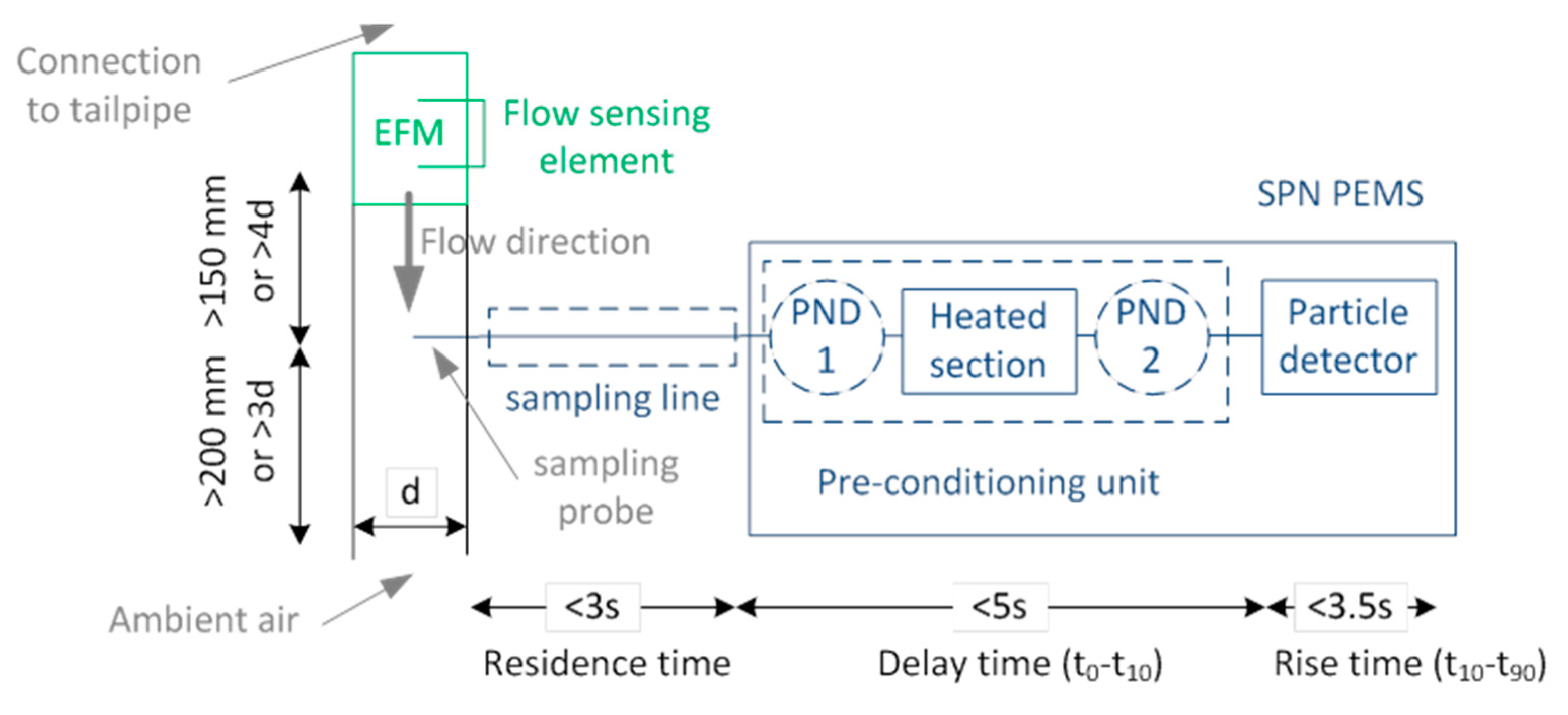
Appendix B
References
- Mannucci, P.; Franchini, M. Health effects of ambient air pollution in developing countries. Int. J. Environ. Res. Public Health 2017, 14, 1048. [Google Scholar] [CrossRef] [PubMed]
- Jaganathan, S.; Jaacks, L.M.; Magsumbol, M.; Walia, G.K.; Sieber, N.L.; Shivasankar, R.; Dhillon, P.K.; Hameed, S.S.; Schwartz, J.; Prabhakaran, D. Association of long-term exposure to fine particulate matter and cardio-metabolic diseases in low- and middle-income countries: A systematic review. Int. J. Environ. Res. Public Health 2019, 16, 2541. [Google Scholar] [CrossRef] [PubMed]
- Takeshita, T. Global scenarios of air pollutant emissions from road transport through to 2050. Int. J. Environ. Res. Public Health 2011, 8, 3032–3062. [Google Scholar] [CrossRef] [PubMed]
- Karagulian, F.; Belis, C.A.; Dora, C.F.C.; Prüss-Ustün, A.M.; Bonjour, S.; Adair-Rohani, H.; Amann, M. Contributions to cities’ ambient particulate matter (PM): A systematic review of local source contributions at global level. Atmos. Environ. 2015, 120, 475–483. [Google Scholar] [CrossRef]
- Guerreiro, C.; González Ortiz, A.; de Leeuw, F.; Viana, M.; Colette, A. Air Quality in Europe—2018 Report; European Environment Agency: Copenhagen, Denmark, 2018; ISBN 978-92-9213-989-6. [Google Scholar]
- Fang, X.; Li, R.; Xu, Q.; Bottai, M.; Fang, F.; Cao, Y. A two-stage method to estimate the contribution of road traffic to PM2.5 concentrations in Beijing, China. Int. J. Environ. Res. Public Health 2016, 13, 124. [Google Scholar] [CrossRef]
- Segersson, D.; Eneroth, K.; Gidhagen, L.; Johansson, C.; Omstedt, G.; Nylén, A.E.; Forsberg, B. Health impact of PM10, PM2.5 and black carbon exposure due to different source sectors in Stockholm, Gothenburg and Umea, Sweden. Int. J. Environ. Res. Public Health 2017, 14, 742. [Google Scholar] [CrossRef]
- Kumar, P.; Morawska, L.; Birmili, W.; Paasonen, P.; Hu, M.; Kulmala, M.; Harrison, R.M.; Norford, L.; Britter, R. Ultrafine particles in cities. Environ. Int. 2014, 66, 1–10. [Google Scholar] [CrossRef]
- Giechaskiel, B.; Maricq, M.; Ntziachristos, L.; Dardiotis, C.; Wang, X.; Axmann, H.; Bergmann, A.; Schindler, W. Review of motor vehicle particulate emissions sampling and measurement: From smoke and filter mass to particle number. J. Aerosol Sci. 2014, 67, 48–86. [Google Scholar] [CrossRef]
- Giechaskiel, B.; Schindler, W.; Jörgl, H.; Vescoli, V.; Bergmann, A.; Silvis, W. Accuracy of Particle Number Measurements from Partial Flow Dilution Systems; SAE International: Warrendale, PA, USA, 2011. [Google Scholar] [CrossRef]
- Giechaskiel, B.; Mamakos, A.; Andersson, J.; Dilara, P.; Martini, G.; Schindler, W.; Bergmann, A. Measurement of automotive nonvolatile particle number emissions within the European legislative framework: A review. Aerosol Sci. Technol. 2012, 46, 719–749. [Google Scholar] [CrossRef]
- Giechaskiel, B.; Dilara, P.; Andersson, J. Particle measurement programme (PMP) light-duty inter-laboratory exercise: Repeatability and reproducibility of the particle number method. Aerosol Sci. Technol. 2008, 42, 528–543. [Google Scholar] [CrossRef]
- Giechaskiel, B.; Drossinos, Y. Theoretical investigation of volatile removal efficiency of particle number measurement systems. SAE Int. J. Engines 2010, 3, 1140–1151. [Google Scholar] [CrossRef]
- Giechaskiel, B.; Lähde, T.; Suarez-Bertoa, R.; Clairotte, M.; Grigoratos, T.; Zardini, A.; Perujo, A.; Martini, G. Particle number measurements in the European legislation and future JRC activities. Combust. Engines 2018, 174, 3–16. [Google Scholar]
- Franco, V.; Kousoulidou, M.; Muntean, M.; Ntziachristos, L.; Hausberger, S.; Dilara, P. Road vehicle emission factors development: A review. Atmos. Environ. 2013, 70, 84–97. [Google Scholar] [CrossRef]
- Weiss, M.; Bonnel, P.; Hummel, R.; Provenza, A.; Manfredi, U. On-road emissions of light-duty vehicles in Europe. Environ. Sci. Technol. 2011, 45, 8575–8581. [Google Scholar] [CrossRef]
- Valverde, V.; Mora, B.A.; Clairotte, M.; Pavlovic, J.; Suarez-Bertoa, R.; Giechaskiel, B.; Astorga-LLorens, C.; Fontaras, G. Emission factors derived from 13 Euro 6b light-duty vehicles based on laboratory and on-road measurements. Atmosphere 2019, 10, 243. [Google Scholar] [CrossRef]
- Giechaskiel, B.; Riccobono, F.; Vlachos, T.; Mendoza-Villafuerte, P.; Suarez-Bertoa, R.; Fontaras, G.; Bonnel, P.; Weiss, M. Vehicle emission factors of solid nanoparticles in the laboratory and on the road using portable emission measurement systems (PEMS). Front. Environ. Sci. 2015, 3, 82. [Google Scholar] [CrossRef]
- Li, T.; Chen, X.; Yan, Z. Comparison of fine particles emissions of light-duty gasoline vehicles from chassis dynamometer tests and on-road measurements. Atmos. Environ. 2013, 68, 82–91. [Google Scholar] [CrossRef]
- Bergmann, M.; Kirchner, U.; Vogt, R.; Benter, T. On-road and laboratory investigation of low-level PM emissions of a modern diesel particulate filter equipped diesel passenger car. Atmos. Environ. 2009, 43, 1908–1916. [Google Scholar] [CrossRef]
- Rubino, L.; Bonnel, P.; Hummel, R.; Krasenbrink, A.; Manfredi, U.; De Santi, G. On-road emissions and fuel economy of light duty vehicles using PEMS: Chase-testing experiment. SAE Int. J. Fuels Lubr. 2008, 1, 1454–1468. [Google Scholar] [CrossRef]
- Giechaskiel, B.; Suarez-Bertoa, R.; Lahde, T.; Clairotte, M.; Carriero, M.; Bonnel, P.; Maggiore, M. Emissions of a Euro 6b diesel passenger car retrofitted with a solid ammonia reduction system. Atmosphere 2019, 10, 180. [Google Scholar] [CrossRef]
- Giechaskiel, B.; Suarez-Bertoa, R.; Lähde, T.; Clairotte, M.; Carriero, M.; Bonnel, P.; Maggiore, M. Evaluation of NOx emissions of a retrofitted Euro 5 passenger car for the Horizon prize “Engine retrofit”. Environ. Res. 2018, 166, 298–309. [Google Scholar] [CrossRef] [PubMed]
- Hou, L.; Zhang, K.; Luthin, M.; Baccarelli, A. Public health impact and economic costs of Volkswagen’s lack of compliance with the United States’ emission standards. Int. J. Environ. Res. Public Health 2016, 13, 891. [Google Scholar] [CrossRef] [PubMed]
- Vlachos, T.G.; Bonnel, P.; Perujo, A.; Weiss, M.; Villafuerte, P.M.; Riccobono, F. In-use emissions testing with portable emissions measurement systems (PEMS) in the current and future european vehicle emissions legislation: Overview, underlying principles and expected benefits. SAE Int. J. Commer. Veh. 2014, 7, 199–215. [Google Scholar] [CrossRef]
- Giechaskiel, B.; Vlachos, T.; Riccobono, F.; Forni, F.; Colombo, R.; Montigny, F.; Le-Lijour, P.; Carriero, M.; Bonnel, P.; Weiss, M. Implementation of portable emissions measurement systems (PEMS) for the real-driving emissions (RDE) regulation in Europe. JoVE 2016, 54753. [Google Scholar] [CrossRef] [PubMed]
- Giechaskiel, B.; Clairotte, M.; Valverde-Morales, V.; Bonnel, P.; Kregar, Z.; Franco, V.; Dilara, P. Framework for the assessment of PEMS (portable emissions measurement systems) uncertainty. Environ. Res. 2018, 166, 251–260. [Google Scholar] [CrossRef] [PubMed]
- Andersson, J.; May, J.; Favre, C.; Bosteels, D.; de Vries, S.; Heaney, M.; Keenan, M.; Mansell, J. On-road and chassis dynamometer evaluations of emissions from two Euro 6 diesel vehicles. SAE Int. J. Fuels Lubr. 2014, 7, 919–934. [Google Scholar] [CrossRef]
- Giechaskiel, B.; Arndt, M.; Schindler, W.; Bergmann, A.; Silvis, W.; Drossinos, Y. Sampling of non-volatile vehicle exhaust particles: A simplified guide. SAE Int. J. Engines 2012, 5, 379–399. [Google Scholar] [CrossRef]
- Giechaskiel, B.; Lähde, T.; Drossinos, Y. Regulating particle number measurements from the tailpipe of light-duty vehicles: The next step? Environ. Res. 2019, 172, 1–9. [Google Scholar] [CrossRef]
- Giechaskiel, B. Differences between tailpipe and dilution tunnel sub-23 nm non-volatile (solid) particle number measurements. Aerosol Sci. Technol. 2019, 1–13. [Google Scholar] [CrossRef]
- Giechaskiel, B. Effect of sampling conditions on the sub-23 nm nonvolatile particle emissions measurements of a moped. Appl. Sci. 2019, 9, 3112. [Google Scholar] [CrossRef]
- Jetter, J.; Maeshiro, S.; Hatcho, S.; Klebba, R. Development of an On-Board Analyzer for Use on Advanced Low Emission Vehicles. J. Fuels Lubr. 2000, 109, 755–762. [Google Scholar]
- Vojtisek-Lom, M.; Allsop, J.E. Development of Heavy-Duty Diesel Portable, On-Board Mass Exhaust Emissions Monitoring System with NOx, CO2 and Qualitative PM Capabilities; SAE International: Warrendale, PA, USA, 2001. [Google Scholar] [CrossRef]
- Feist, M.D.; Sharp, C.A.; Spears, M.W. Determination of pems measurement allowances for gaseous emissions regulated under the heavy-duty diesel engine in-use testing program: Part 1—Project overview and PEMS evaluation procedures. SAE Int. J. Fuels Lubr. 2009, 2, 435–454. [Google Scholar] [CrossRef]
- Bougher, T.L.; Khalek, I.A.; Laroo, C.A.; Bishnu, D.K. Determination of the PEMS measurement allowance for pm emissions regulated under the heavy-duty diesel engine in-use testing program. SAE Int. J. Engines 2012, 5, 1371–1386. [Google Scholar] [CrossRef]
- Bonnel, P.; Kubelt, J.; Provenza, A.; Institute for Energy (European Commission). Heavy-Duty Engines Conformity Testing Based on Pems: Lessons Learned from the European Pilot Program; Publications Office: Luxembourg, 2011; ISBN 978-92-79-21039-6. [Google Scholar]
- Bonnel, P.; Carriero, M.; Forni, F.; Alessandrini, S.; Montigny, F.; Demircioglu, H.; Giechaskiel, B. EU-PEMS PM Evaluation Program: First Report; Publications Office: Luxembourg, 2010; ISBN 978-3-8443-7399-8. [Google Scholar]
- Giechaskiel, B.; Carriero, M.; Bonnel, P.; Schindler, W.; Scheder, D.; Bassoli, C.; Niemela, V. Feasibility of Particulate Mass and Number Measurement with Portable Emission Measurement Systems (PEMS) for In-Use Testing; SAE International: Warrendale, PA, USA, 2011. [Google Scholar] [CrossRef]
- Mamakos, A.; Bonnel, P.; Perujo, A.; Carriero, M. Assessment of portable emission measurement systems (PEMS) for heavy-duty diesel engines with respect to particulate matter. J. Aerosol Sci. 2013, 57, 54–70. [Google Scholar] [CrossRef]
- Villafuerte, P.M.; del Parque, A.P.M.; Bonnel, P.; Carriero, M.; Forni, F.; Riccobono, F.; European Commission; Joint Research Centre; Institute for Energy and Transport. EU-PEMS PM Pilot Program: Testing, Data Analysis and Results; Publications Office: Luxembourg, 2015; ISBN 978-92-79-49236-5. [Google Scholar]
- Del Parque, A.P.M.; Villafuerte, P.M.; European Commission; Joint Research Centre; Institute for Energy and Transport. PEMS Emissions Testing of Heavy Duty Vehicles/Assessment of PEMS Procedures in Fulfilment of Article 14(3) to Regulation (EU) 582/2011; Publications Office: Luxembourg, 2015. [Google Scholar]
- Giechaskiel, B.; Riccobono, F.; Bonnel, P. Feasibility Study on the Extension of the Real-Driving Emissions (RDE) Procedure to Particle Number (PN): Experimental Evaluation of Portable Emission Measurement Systems (PEMS) with Diffusion Chargers (DCs) to Measure Particle Number (PN) Concentration; Publications Office: Luxembourg, 2014. [Google Scholar]
- Riccobono, F.; Giechaskiel, B.; Weiss, M.; Bonnel, P. How to extend the real drive emission test procedure to particle number. In Proceedings of the 18th ETH Conference on Combustion Generated Nanoparticles, Zürich, Switzerland, 25 June 2014. [Google Scholar]
- Giechaskiel, B.; Riccobono, F.; Bonnel, P. Feasibility Study on the Extension of the Real-Driving Emissions (RDE) Procedure to Particle Number (PN): Chassis Dynamometer Evaluation of Portable Emission Measurement Systems (PEMS) to Measure Particle Number (PN) Concentration: Phase II; Publications Office: Luxembourg, 2015; ISBN 978-92-79-51003-8. [Google Scholar]
- Riccobono, F.; Giechaskiel, B.; Villafuerte, P.M. Particle Number PEMS Inter-Laboratory Comparison Exercise; Publications Office: Luxembourg, 2016. [Google Scholar]
- Hämeri, K.; Koponen, I.K.; Aalto, P.P.; Kulmala, M. The particle detection efficiency of the TSI-3007 condensation particle counter. J. Aerosol Sci. 2002, 33, 1463–1469. [Google Scholar] [CrossRef]
- Mordas, G.; Manninen, H.E.; Petäjä, T.; Aalto, P.P.; Hämeri, K.; Kulmala, M. On operation of the ultra-fine water-based CPC TSI 3786 and comparison with other TSI models (TSI 3776, TSI 3772, TSI 3025, TSI 3010, TSI 3007). Aerosol Sci. Technol. 2008, 42, 152–158. [Google Scholar] [CrossRef]
- Asbach, C.; Kaminski, H.; Von Barany, D.; Kuhlbusch, T.; Monz, C.; Dziurowitz, N.; Pelzer, J.; Vossen, K.; Berlin, K.; Dietrich, S.; et al. Comparability of portable nanoparticle exposure monitors. Ann. Occup. Hyg. 2012, 56, 606–621. [Google Scholar]
- Matson, U.; Ekberg, L.E.; Afshari, A. Measurement of ultrafine particles: A comparison of two handheld condensation particle counters. Aerosol Sci. Technol. 2004, 38, 487–495. [Google Scholar] [CrossRef]
- Meier, R.; Clark, K.; Riediker, M. Comparative testing of a miniature diffusion size classifier to assess airborne ultrafine particles under field conditions. Aerosol Sci. Technol. 2013, 47, 22–28. [Google Scholar] [CrossRef]
- Moosmüller, H.; Chakrabarty, R.K.; Arnott, W.P. Aerosol light absorption and its measurement: A review. J. Quant. Spectrosc. Radiat. Transf. 2009, 110, 844–878. [Google Scholar] [CrossRef]
- Schriefl, M.A.; Bergmann, A.; Fierz, M. Design principles for sensing particle number concentration and mean particle size with unipolar diffusion charging. IEEE Sens. J. 2019, 19, 1392–1399. [Google Scholar] [CrossRef]
- Maricq, M.M. Examining the relationship between black carbon and soot in flames and engine exhaust. Aerosol Sci. Technol. 2014, 48, 620–629. [Google Scholar] [CrossRef]
- Ouf, F.-X.; Sillon, P. Charging efficiency of the electrical low pressure impactor’s corona charger: Influence of the fractal morphology of nanoparticle aggregates and uncertainty analysis of experimental results. Aerosol Sci. Technol. 2009, 43, 685–698. [Google Scholar] [CrossRef]
- Qi, C.; Asbach, C.; Shin, W.G.; Fissan, H.; Pui, D.Y.H. The effect of particle pre-existing charge on unipolar charging and its implication on electrical aerosol measurements. Aerosol Sci. Technol. 2009, 43, 232–240. [Google Scholar] [CrossRef]
- Giechaskiel, B. Real Driving Emissions (RDE): Particle Number (PN) Portable Emissions Measurement Systems (PEMS) Calibration; Publications Office of the European Union: Luxembourg, 2018; ISBN 978-92-79-77482-9. [Google Scholar]
- Meuller, B.O.; Messing, M.E.; Engberg, D.L.J.; Jansson, A.M.; Johansson, L.I.M.; Norlén, S.M.; Tureson, N.; Deppert, K. Review of spark discharge generators for production of nanoparticle aerosols. Aerosol Sci. Technol. 2012, 46, 1256–1270. [Google Scholar] [CrossRef]
- Giechaskiel, B.; Davok, R.; Melz Giovanella, K.; Jörgl, H.; Diewald, R.; Schindler, W. Particle Generator (APG): A Soot Generator for the On-Site Checks of Particle Number (PN) Measurement Systems; Pacifico: Yokohama, Japan, 2013. [Google Scholar]
- Asbach, C.; Alexander, C.; Clavaguera, S.; Dahmann, D.; Dozol, H.; Faure, B.; Fierz, M.; Fontana, L.; Iavicoli, I.; Kaminski, H.; et al. Review of measurement techniques and methods for assessing personal exposure to airborne nanomaterials in workplaces. Sci. Total Environ. 2017, 603–604, 793–806. [Google Scholar] [CrossRef]
- Borghi, F.; Spinazzè, A.; Rovelli, S.; Campagnolo, D.; Buono, L.D.; Cattaneo, A.; Cavallo, D. Miniaturized monitors for assessment of exposure to air pollutants: A review. Int. J. Environ. Res. Public Health 2017, 14, 909. [Google Scholar] [CrossRef]
- Kim, S.; Kondo, K.; Otsuki, Y.; Haruta, K. A New On-Board PN Analyzer for Monitoring the Real-Driving Condition; SAE International: Warrendale, PA, USA, 2017. [Google Scholar] [CrossRef]
- Bischof, O.F. Recent developments in the measurement of low particulate emissions from mobile sources: A review of particle number legislations. Emiss. Control Sci. Technol. 2015, 1, 203–212. [Google Scholar] [CrossRef]
- Giechaskiel, B.; Riccobono, F.; Mendoza-Villafuerte, P.; Grigoratos, T. Particle Number (PN)—Portable Emissions Measurement Systems (PEMS) Heavy Duty Vehicles Evaluation Phase at the Joint Research Centre (JRC); Publications Office: Luxembourg, 2016. [Google Scholar]
- Schwelberger, M.; Giechaskiel, B. Evaluation of Portable Number Emission Systems for Heavy-Duty Applications under Steady State and Transient Vehicle Operation Conditions on a Chassis Dynamometer; SAE International: Warrendale, PA, USA, 2018. [Google Scholar] [CrossRef]
- Giechaskiel, B.; Schwelberger, M.; Delacroix, C.; Marchetti, M.; Feijen, M.; Prieger, K.; Andersson, S.; Karlsson, H.L. Experimental assessment of solid particle number portable emissions measurement systems (PEMS) for heavy-duty vehicles applications. J. Aerosol Sci. 2018, 123, 161–170. [Google Scholar] [CrossRef]
- Schwelberger, M.; Mamakos, A.; Fierz, M.; Giechaskiel, B. Experimental assessment of an electrofilter and a tandem positive-negative corona charger for the measurement of charged nanoparticles formed in selective catalytic reduction systems. Appl. Sci. 2019, 9, 1051. [Google Scholar] [CrossRef]
- Mamakos, A.; Schwelberger, M.; Fierz, M.; Giechaskiel, B. Effect of selective catalytic reduction on exhaust nonvolatile particle emissions of Euro VI heavy-duty compression ignition vehicles. Aerosol Sci. Technol. 2019, 53, 898–910. [Google Scholar] [CrossRef]
- Amanatidis, S.; Ntziachristos, L.; Giechaskiel, B.; Bergmann, A.; Samaras, Z. Impact of selective catalytic reduction on exhaust particle formation over excess ammonia events. Environ. Sci. Technol. 2014, 48, 11527–11534. [Google Scholar] [CrossRef] [PubMed]
- Mendoza-Villafuerte, P.; Suarez-Bertoa, R.; Giechaskiel, B.; Riccobono, F.; Bulgheroni, C.; Astorga, C.; Perujo, A. NOx, NH3, N2O and PN real driving emissions from a Euro VI heavy-duty vehicle. Impact of regulatory on-road test conditions on emissions. Sci. Total Environ. 2017, 609, 546–555. [Google Scholar] [CrossRef] [PubMed]
- Giechaskiel, B. Solid particle number emission factors of Euro VI heavy-duty vehicles on the road and in the laboratory. Int. J. Environ. Res. Public Health 2018, 15, 304. [Google Scholar] [CrossRef] [PubMed]
- Giechaskiel, B.; Carriero, M.; Martini, G.; Bergmann, A.; Pongratz, H.; Joergl, H. Comparison of Particle Number Measurements from the Full Dilution Tunnel, the Tailpipe and Two Partial Flow Systems; SAE International: Warrendale, PA, USA, 2010. [Google Scholar] [CrossRef]
- European Committee for Standardization CEN/TC 301, WI=00301067. Road Vehicles—Portable Emission Measuring Systems (PEMS)—Performance Assessment; Proposal for European Standard 2018; European Committee for Standardization: Brussels, Belgium, 2018. [Google Scholar]
- EMPIR. EMPIR Call 2019—Energy, Environment, Normative and Research Potential: Selected Research Topic Number: SRT-v07 2019; EURAMET: Braunschweig, Germany, 2019. [Google Scholar]
- Giechaskiel, B.; Joshi, A.; Ntziachristos, L.; Dilara, P. European regulatory framework and particulate matter emissions of gasoline light-duty vehicles: A review. Catalysts 2019, 9, 586. [Google Scholar] [CrossRef]
- Merkisz, J.; Bielaczyc, P.; Pielecha, J.; Woodburn, J. RDE Testing of Passenger Cars: The Effect of the Cold Start on the Emissions Results; SAE International: Warrendale, PA, USA, 2019. [Google Scholar] [CrossRef]
- Suarez-Bertoa, R.; Lähde, T.; Pavlovic, J.; Valverde, V.; Clairotte, M.; Giechaskiel, B. Laboratory and on-road evaluation of a GPF-equipped gasoline vehicle. Catalysts 2019, 9, 678. [Google Scholar] [CrossRef]
- Giechaskiel, B.; Gioria, R.; Carriero, M.; Lähde, T.; Forloni, F.; Perujo, A.; Martini, G.; Bissi, L.M.; Terenghi, R. Emission factors of a Euro VI heavy-duty diesel refuse collection vehicle. Sustainability 2019, 11, 1067. [Google Scholar] [CrossRef]
- Giechaskiel, B.; Bergmann, A. Validation of 14 used, re-calibrated and new TSI 3790 condensation particle counters according to the UN-ECE Regulation 83. J. Aerosol Sci. 2011, 42, 195–203. [Google Scholar] [CrossRef]
- Asbach, C.; Kaminski, H.; Lamboy, Y.; Schneiderwind, U.; Fierz, M.; Todea, A.M. Silicone sampling tubes can cause drastic artifacts in measurements with aerosol instrumentation based on unipolar diffusion charging. Aerosol Sci. Technol. 2016, 50, 1375–1384. [Google Scholar] [CrossRef]
- Amanatidis, S.; Maricq, M.M.; Ntziachristos, L.; Samaras, Z. Application of the dual Pegasor Particle Sensor to real-time measurement of motor vehicle exhaust PM. J. Aerosol Sci. 2017, 103, 93–104. [Google Scholar] [CrossRef]
- Giechaskiel, B.; Casadei, S.; Mazzini, M.; Sammarco, M.; Montabone, G.; Tonelli, R.; Deana, M.; Costi, G.; Di Tanno, F.; Prati, M.; et al. Inter-laboratory correlation exercise with portable emissions measurement systems (PEMS) on chassis dynamometers. Appl. Sci. 2018, 8, 2275. [Google Scholar] [CrossRef]
- Giechaskiel, B.; Vanhanen, J.; Väkevä, M.; Martini, G. Investigation of vehicle exhaust sub-23 nm particle emissions. Aerosol Sci. Technol. 2017, 51, 626–641. [Google Scholar] [CrossRef]
- Barrios, C.C.; Domínguez-Sáez, A.; Rubio, J.R.; Pujadas, M. Development and evaluation of on-board measurement system for nanoparticle emissions from diesel engine. Aerosol Sci. Technol. 2011, 45, 570–580. [Google Scholar] [CrossRef]
- Symonds, J.P.R.; Rushton, M.G.; Reavell, K. On Road Particulate Emissions from a Diesel Passenger Car Around Cambridge. Master’ Thesis, University College London, London, UK, 2007. [Google Scholar]
- Hu, H.; Zou, Z.; Yang, H. On-Board Measurements of City Buses with Hybrid Electric Powertrain, Conventional Diesel and LPG Engines; SAE International: Warrendale, PA, USA, 2009. [Google Scholar] [CrossRef]
- Qi, C.; Kulkarni, P. Unipolar charging based, hand-held mobility spectrometer for aerosol size distribution measurement. J. Aerosol Sci. 2012, 49, 32–47. [Google Scholar] [CrossRef]
- Giechaskiel, B.; Lähde, T.; Schwelberger, M.; Kleinbach, T.; Roske, H.; Teti, E.; van den Bos, T.; Neils, P.; Delacroix, C.; Jakobsson, T.; et al. Particle number measurements directly from the tailpipe for type approval of heavy-duty engines. Appl. Sci. 2019, 9, 4418. [Google Scholar] [CrossRef]
- Burtscher, H.; Lutz, T.H.; Mayer, A. A new periodic technical inspection for particle emissions of vehicles. Emiss. Control Sci. Technol. 2019, 5, 279–287. [Google Scholar] [CrossRef]
- Yang, J.; Durbin, T.D.; Jiang, Y.; Tange, T.; Karavalakis, G.; Cocker, D.R.; Johnson, K.C. A comparison of a mini-PEMS and a 1065 compliant PEMS for on-road gaseous and particulate emissions from a light duty diesel truck. Sci. Total Environ. 2018, 640–641, 364–376. [Google Scholar] [CrossRef]
- Kontses, D.; Geivanidis, S.; Fragkiadoulakis, P.; Samaras, Z. Uncertainties in model-based diesel particulate filter diagnostics using a soot sensor. Sensors 2019, 19, 3141. [Google Scholar] [CrossRef]
- Giechaskiel, B.; Cresnoverh, M.; Jörgl, H.; Bergmann, A. Calibration and accuracy of a particle number measurement system. Meas. Sci. Technol. 2010, 21, 045102. [Google Scholar] [CrossRef]
- Giechaskiel, B.; Wang, X.; Horn, H.-G.; Spielvogel, J.; Gerhart, C.; Southgate, J.; Jing, L.; Kasper, M.; Drossinos, Y.; Krasenbrink, A. Calibration of condensation particle counters for legislated vehicle number emission measurements. Aerosol Sci. Technol. 2009, 43, 1164–1173. [Google Scholar] [CrossRef]
- Hueglin, C.H.; Scherrer, L.; Burtscher, H. An accurate, continuously adjustable dilution system (1:10 to 1:10^4) for submicron aerosols. J. Aerosol Sci. 1997, 28, 1049–1055. [Google Scholar] [CrossRef]
- Wilson, W.E.; Stanek, J.; Han, H.-S.; Johnson, T.; Sakurai, H.; Pui, D.Y.H.; Turner, J.; Chen, D.-R.; Duthie, S. Use of the electrical aerosol detector as an indicator of the surface area of fine particles deposited in the lung. J. Air Waste Manag. Assoc. 2007, 57, 211–220. [Google Scholar] [CrossRef] [PubMed]
- Besch, M.C.; Thiruvengadam, A.; Kappanna, H.K.; Cozzolini, A.; Carder, D.K.; Gautam, M.; Tikkanen, J. Assessment of novel in-line particulate matter sensor with respect to OBD and emissions control applications. In Proceedings of the ASME 2011 Internal Combustion Engine Division Fall Technical Conference, Baltimore, MD, USA, 17–21 July 2011; ASME: Morgantown, WV, USA, 2011; pp. 689–701. [Google Scholar]
- Ntziachristos, L.; Amanatidis, S.; Samaras, Z.; Janka, K.; Tikkanen, J. Application of the Pegasor particle sensor for the measurement of mass and particle number emissions. SAE Int. J. Fuels Lubr. 2013, 6, 521–531. [Google Scholar] [CrossRef]
- Fierz, M.; Meier, D.; Steigmeier, P.; Burtscher, H. Aerosol measurement by induced currents. Aerosol Sci. Technol. 2014, 48, 350–357. [Google Scholar] [CrossRef]
- Fierz, M.; Houle, C.; Steigmeier, P.; Burtscher, H. Design, calibration, and field performance of a miniature diffusion size classifier. Aerosol Sci. Technol. 2011, 45, 1–10. [Google Scholar] [CrossRef]
- Yamada, H.; Okuda, H. New particle number measurement method equivalent to particle measurement programme methodology. Int. J. Engine Res. 2017, 18, 621–630. [Google Scholar] [CrossRef]
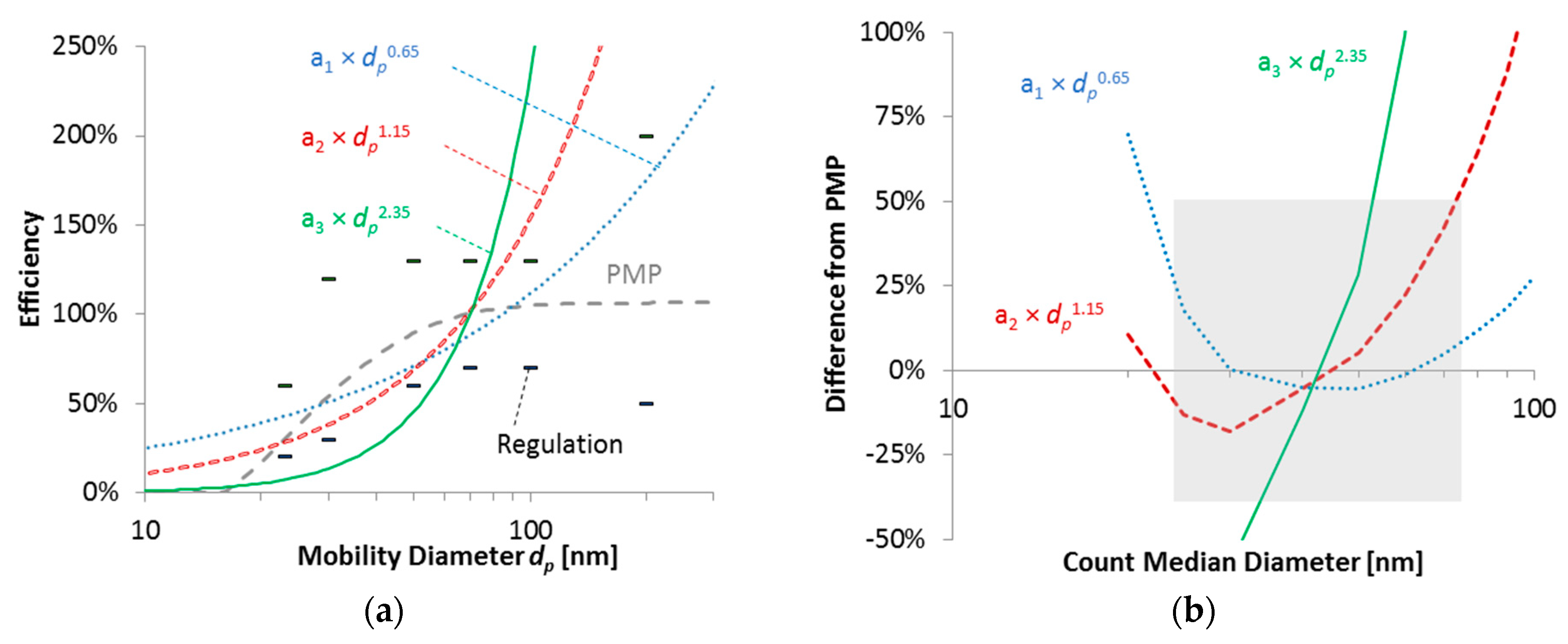
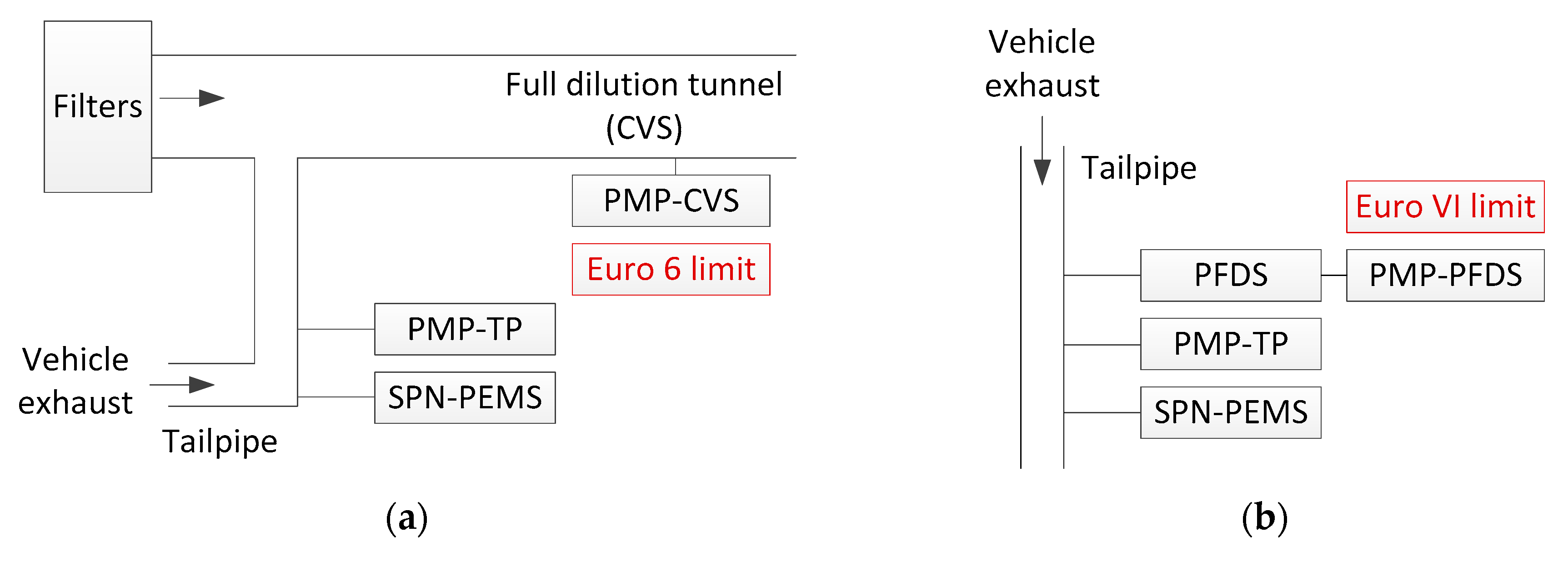
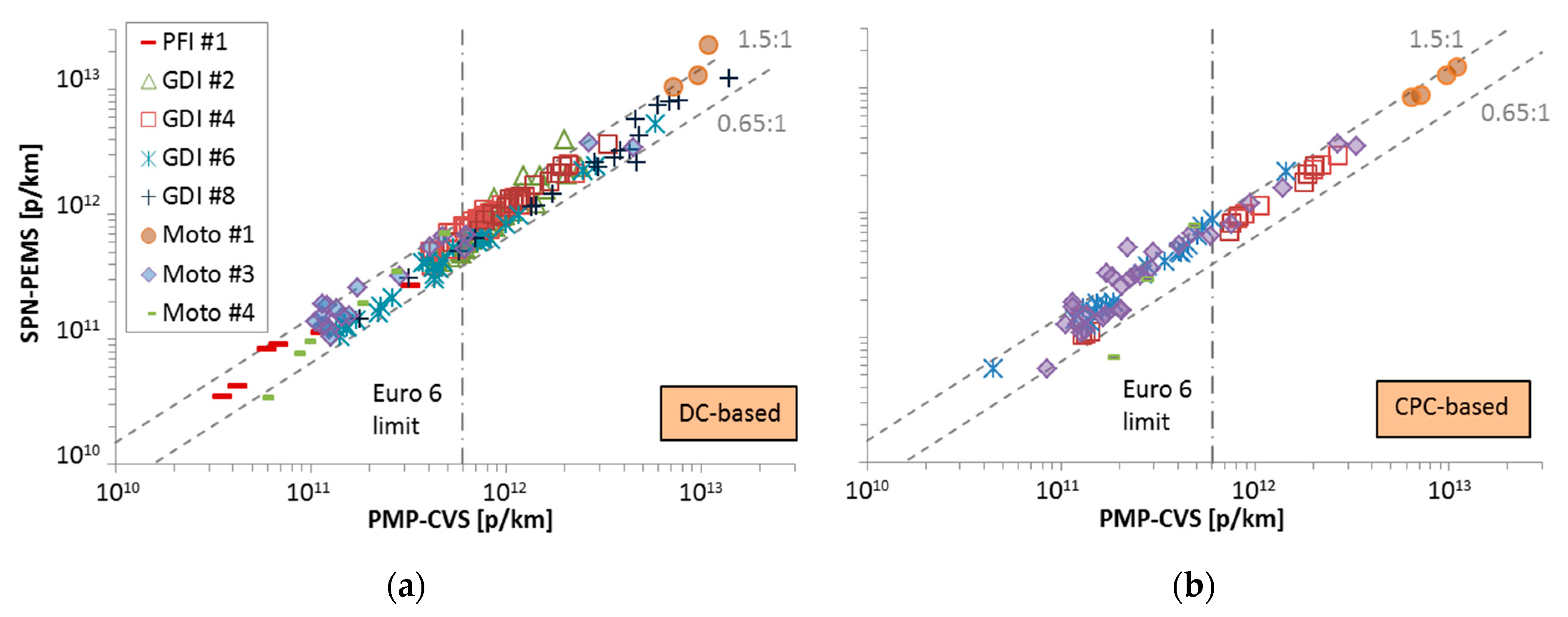
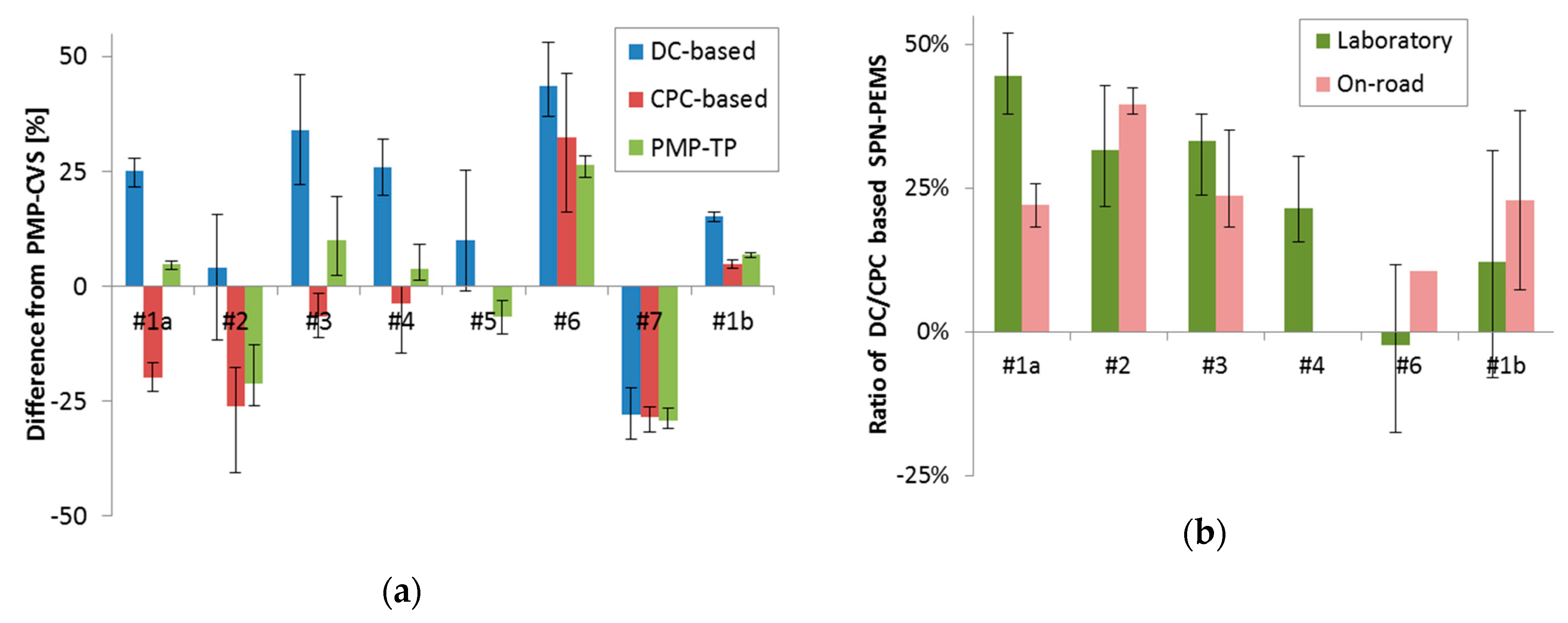
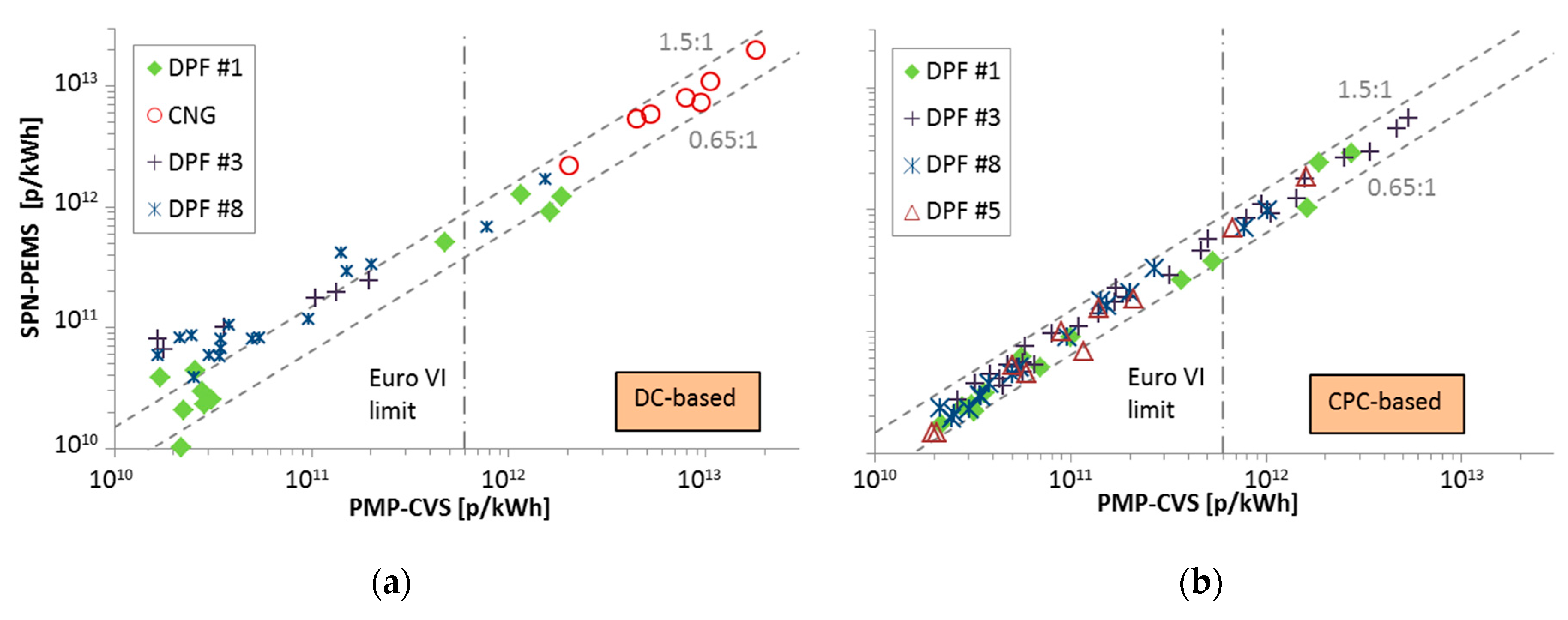
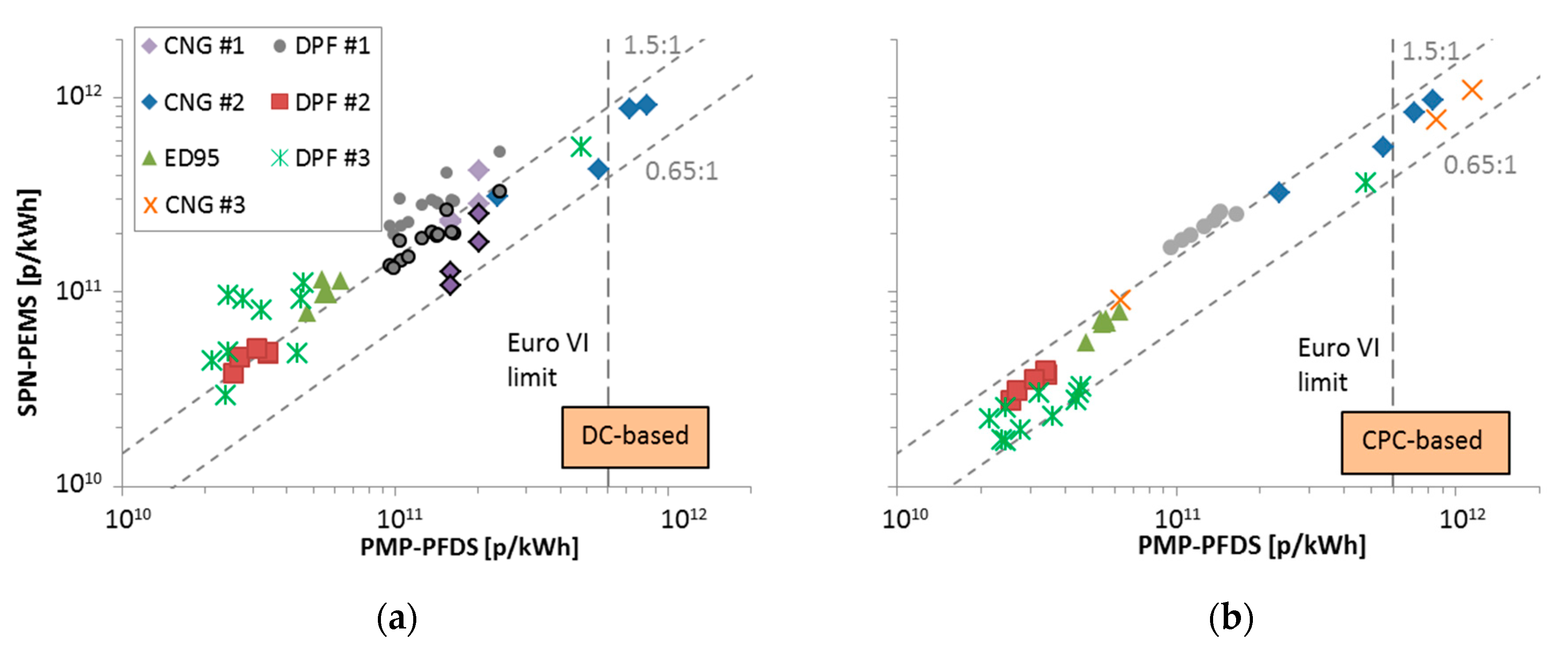
| SPN-PEMS | Exponent [43] (DC’s; Soot) | Theoretical 1 [43] Mid 2013 | Phase I [44] Oct–Dec 2013 | Phase II [45] Sep–Dec 2014 | ILCE 2 [46] Sep–Dec 2015 |
|---|---|---|---|---|---|
| AVL (DC) | 1.26 | −45% to +43% | −42% to +102% | −49% to +48% | − |
| Horiba (DC) 3, 4 | 1.16 | −71% to +32% | −96% to +95% | +11% to +150% | − |
| Testo (DC) | 1.18 | −44% to +24% | −49% to +83% | −48% to +55% | −39% to +42% |
| Pegasor (DC) 3 | 1.35 | −33% to +97% | −43% to +118% | −58% to +199% | − |
| Sensors (DC) 4 | (1.35) | −44% to +90% | −35% to +188% | −85% to +309% | − |
| Shimadzu (DC) 3 | − | − | − | −35% to +97% | − |
| Sensors (CPC) | − | − | − | issues | − |
| Horiba (CPC) | − | − | − | −21% to +49% | −41% to +54% |
| Maha (CPC) | − | − | − | −45% to +49% | − |
| PMP (CPC) | − | − | −29% to +56% | −28% to +49% | − |
| SPN-PEMS | Phase I [64] Feb–Jun 2016 | Phase II [65] Sep 2016 1 | ILE [66] Feb–Dec 2017 | Additional [67] Jan–Apr 2018 |
|---|---|---|---|---|
| AVL (DC) | - | 3% to +111% | 42% 1 | −24% to +42% |
| Testo (DC) | −39% to +40% | 36% to +84% | −59% to +165% | − |
| Sensors (CPC) | - | - | −44% to −14% 1 | − |
| Horiba (CPC) | −43% to +32% | −9% to +25% | −37% to +79% | +2% to +38% |
| Maha (CPC) | - | −47% to −18% | − | − |
| PMP (CPC) | −22% to +34% | −13% to +5% | −33% to 46% 1 | − |
© 2019 by the authors. Licensee MDPI, Basel, Switzerland. This article is an open access article distributed under the terms and conditions of the Creative Commons Attribution (CC BY) license (http://creativecommons.org/licenses/by/4.0/).
Share and Cite
Giechaskiel, B.; Bonnel, P.; Perujo, A.; Dilara, P. Solid Particle Number (SPN) Portable Emissions Measurement Systems (PEMS) in the European Legislation: A Review. Int. J. Environ. Res. Public Health 2019, 16, 4819. https://doi.org/10.3390/ijerph16234819
Giechaskiel B, Bonnel P, Perujo A, Dilara P. Solid Particle Number (SPN) Portable Emissions Measurement Systems (PEMS) in the European Legislation: A Review. International Journal of Environmental Research and Public Health. 2019; 16(23):4819. https://doi.org/10.3390/ijerph16234819
Chicago/Turabian StyleGiechaskiel, Barouch, Pierre Bonnel, Adolfo Perujo, and Panagiota Dilara. 2019. "Solid Particle Number (SPN) Portable Emissions Measurement Systems (PEMS) in the European Legislation: A Review" International Journal of Environmental Research and Public Health 16, no. 23: 4819. https://doi.org/10.3390/ijerph16234819
APA StyleGiechaskiel, B., Bonnel, P., Perujo, A., & Dilara, P. (2019). Solid Particle Number (SPN) Portable Emissions Measurement Systems (PEMS) in the European Legislation: A Review. International Journal of Environmental Research and Public Health, 16(23), 4819. https://doi.org/10.3390/ijerph16234819




